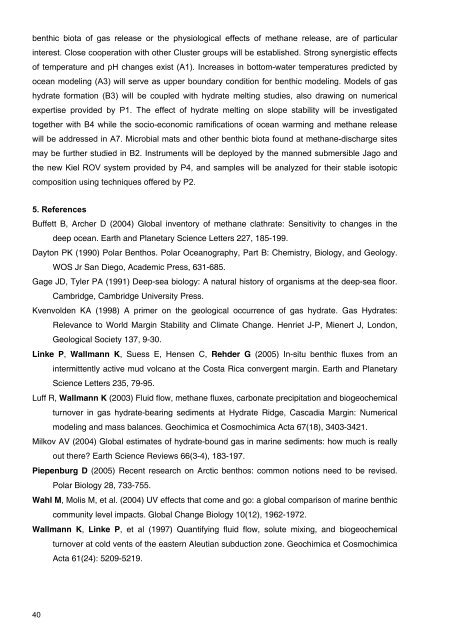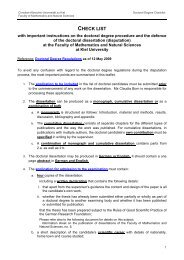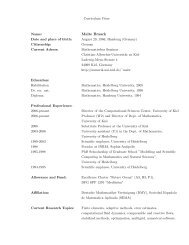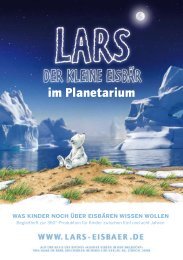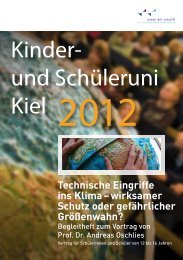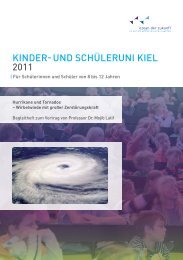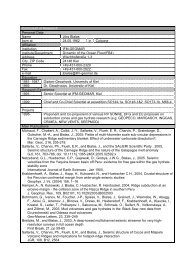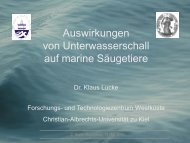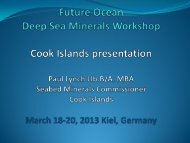Untitled - The Future Ocean
Untitled - The Future Ocean
Untitled - The Future Ocean
- No tags were found...
Create successful ePaper yourself
Turn your PDF publications into a flip-book with our unique Google optimized e-Paper software.
enthic biota of gas release or the physiological effects of methane release, are of particularinterest. Close cooperation with other Cluster groups will be established. Strong synergistic effectsof temperature and pH changes exist (A1). Increases in bottom-water temperatures predicted byocean modeling (A3) will serve as upper boundary condition for benthic modeling. Models of gashydrate formation (B3) will be coupled with hydrate melting studies, also drawing on numericalexpertise provided by P1. <strong>The</strong> effect of hydrate melting on slope stability will be investigatedtogether with B4 while the socio-economic ramifications of ocean warming and methane releasewill be addressed in A7. Microbial mats and other benthic biota found at methane-discharge sitesmay be further studied in B2. Instruments will be deployed by the manned submersible Jago andthe new Kiel ROV system provided by P4, and samples will be analyzed for their stable isotopiccomposition using techniques offered by P2.5. ReferencesBuffett B, Archer D (2004) Global inventory of methane clathrate: Sensitivity to changes in thedeep ocean. Earth and Planetary Science Letters 227, 185-199.Dayton PK (1990) Polar Benthos. Polar <strong>Ocean</strong>ography, Part B: Chemistry, Biology, and Geology.WOS Jr San Diego, Academic Press, 631-685.Gage JD, Tyler PA (1991) Deep-sea biology: A natural history of organisms at the deep-sea floor.Cambridge, Cambridge University Press.Kvenvolden KA (1998) A primer on the geological occurrence of gas hydrate. Gas Hydrates:Relevance to World Margin Stability and Climate Change. Henriet J-P, Mienert J, London,Geological Society 137, 9-30.Linke P, Wallmann K, Suess E, Hensen C, Rehder G (2005) In-situ benthic fluxes from anintermittently active mud volcano at the Costa Rica convergent margin. Earth and PlanetaryScience Letters 235, 79-95.Luff R, Wallmann K (2003) Fluid flow, methane fluxes, carbonate precipitation and biogeochemicalturnover in gas hydrate-bearing sediments at Hydrate Ridge, Cascadia Margin: Numericalmodeling and mass balances. Geochimica et Cosmochimica Acta 67(18), 3403-3421.Milkov AV (2004) Global estimates of hydrate-bound gas in marine sediments: how much is reallyout there? Earth Science Reviews 66(3-4), 183-197.Piepenburg D (2005) Recent research on Arctic benthos: common notions need to be revised.Polar Biology 28, 733-755.Wahl M, Molis M, et al. (2004) UV effects that come and go: a global comparison of marine benthiccommunity level impacts. Global Change Biology 10(12), 1962-1972.Wallmann K, Linke P, et al (1997) Quantifying fluid flow, solute mixing, and biogeochemicalturnover at cold vents of the eastern Aleutian subduction zone. Geochimica et CosmochimicaActa 61(24): 5209-5219.40


